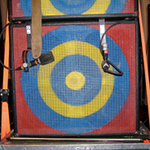The title of John Houck’s first solo exhibition in New York, “To Understand Photography, You Must First Understand Photography,” is a tautological tease, a foil that enables the expected self-reflexive meditations on his medium but brims with an abundance of interpretive directions. To really understand photography, his work suggests, you must also consider history, literature, architecture, mathematics, and religion. Take, for example, the works in the “Echelon” series, such as #7, Axonometric and 27mm Perspective and #9, Axonometric and 27mm Perspective (all works 2012), in which Houck has digitally superimposed two schematic bird’s-eye views of French Romanesque churches and gothic cathedrals and printed them as cyanotypes, a format traditionally used for blueprints. Overlapping distinct forms of perspective—axonometric and orthogonal projection—produces the destabilizing effect of seeing double while blurring the photo’s subject. Diagrammatic depictions of engineering feats transform suggestively into puzzling matters of faith, or of art.
For Untitled #111, from his “Aggregates” series, Houck systematically plotted every possible variation of four colors arranged in a three-by-three grid using his own custom computer software and printed the 262,143 results as an index (or contact) sheet. He then creased the paper diagonally, photographed the entire print, and outputted a second image that he creased again, creating an “X” of actual and virtual folds. The final photo is visually stunning and even soothing with its pixelated field of aqua and rust, not unlike pleasing moiré patterns or television static.
The “Aggregates” feel like an abstracted Google Image search culling from a bottomless well of digital pictures. The series is also analogous to Jorge Luis Borges’s description of the infinite in “The Library of Babel,” where men wander through an endless labyrinth of rooms in search of meaning from the books that line its walls, books that largely contain random, unique, and incomprehensible combinations of letters and punctuation. While Houck’s series echoes familiar binaries—digital/analog, artisanal/mechanical, image/language—it also expresses an underlying fear, pathos, and sense of wonder when facing an infinite, unknowable abyss.
Originally published at Artforum.com on July 26, 2012.
